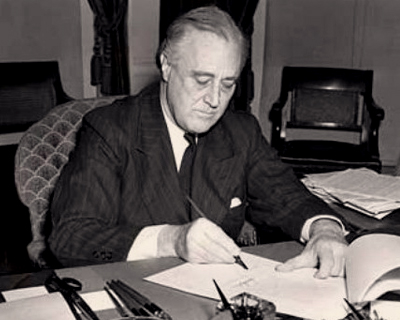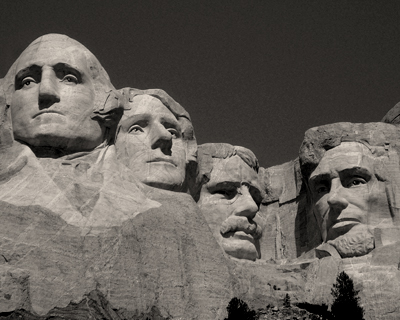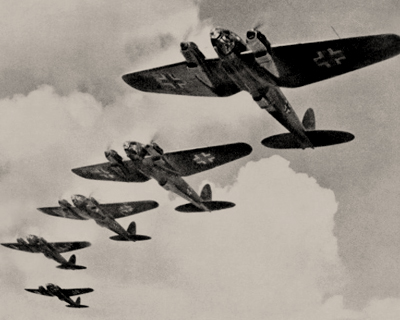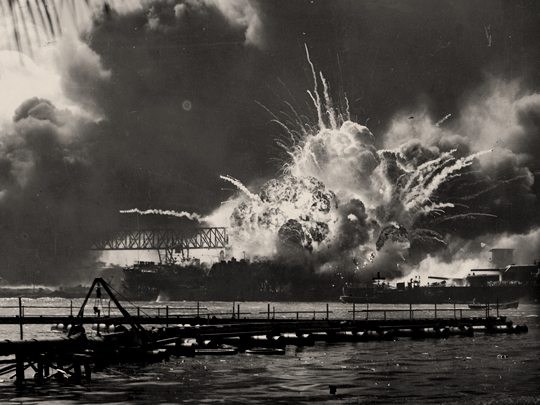U.S. Archives / Wikimedia Commons / CC-BY-SA-3.0 / GFDL
1 – Japanese Surprise Attack on U.S. Fleet at Pearl Harbor
The attack on Pearl Harbor was a surprise military strike by the Imperial Japanese Navy against the United States naval base at Pearl Harbor, Hawaii Territory, on the morning of December 7, 1941.
The attack led to the United States’ entry into World War II.
Japan hoped the attack would keep the U.S. Pacific Fleet from interfering with the military actions Japan planned in Southeast Asia against overseas territories of the United Kingdom, the Netherlands, and the United States.
Over the next seven hours, there were coordinated Japanese attacks on the U.S.-held Philippines, Guam and Wake Island and on the British Empire in Malaya, Singapore, and Hong Kong.
All eight U.S. Navy battleships were damaged, with four sunk. All but Arizona were later raised, and six returned to service and went on to fight in the war.
Cruisers, destroyers, an anti-aircraft training ship, and a minelayer were also attacked. 188 U.S. aircraft were destroyed; 2,403 Americans were killed and 1,178 wounded.
Japanese losses were light: 29 aircraft and five midget submarines lost, and 64 servicemen killed. One Japanese sailor, Kazuo Sakamaki, was captured.
On December 8, the United States declared war on Japan. Domestic support for non-interventionism, which had been fading since the Fall of France in 1940, disappeared.
Germany and Italy declared war on the U.S. on December 11, which was reciprocated by the U.S. the same day.
As the attack happened without a declaration of war and without explicit warning, the attack on Pearl Harbor was judged by the Tokyo Trials to be a war crime.
2 – The First U.S. Lend-Lease Shipment of Food was Sent

The Lend-Lease policy was a program under which the United States supplied Free France, the United Kingdom, the Republic of China, the USSR, and other Allied nations, with food, oil, and material between 1941 and August 1945.
It was signed into law on March 11, 1941, and ended in September 1945. In general, the aid was free, although some hardware (such as ships) were returned after the war.
In return, the U.S. was given leases on the army and naval bases in Allied territory during the war.
A total of $50.1 billion (equivalent to $659 billion today) worth of supplies was shipped, which was 17% of the total war expenditures of the U.S.
In all, $31.4 billion went to Britain, $11.3 billion to the Soviet Union, $3.2 billion to France, $1.6 billion to China, and the remaining $2.6 billion to the other Allies.
Reverse Lend-Lease policies comprised services such as rent on air bases that went to the U.S., and totaled $7.8 billion, with $6.8 billion coming from the British and the Commonwealth.
The terms of the agreement provided that the material was to be used until returned or destroyed. In practice, very little equipment was returned.
3 – Mount Rushmore Monument is Completed

Mount Rushmore National Memorial is a sculpture carved into the granite face of Mount Rushmore, in the Black Hills in Keystone, South Dakota, United States.
Sculpted by Danish-American Gutzon Borglum and his son, Lincoln Borglum, it features 60-foot sculptures of four United States presidents: George Washington, Thomas Jefferson, Theodore Roosevelt, and Abraham Lincoln.
South Dakota historian Doane Robinson is credited with conceiving the idea of carving the likenesses of famous people into the Black Hills region of South Dakota in order to promote tourism in the region.
Robinson wanted it to feature western heroes like Lewis and Clark, Red Cloud, and Buffalo Bill Cody, but Borglum decided the sculpture should have a more national focus and chose the four presidents.
Construction on the memorial began in 1927, and the presidents’ faces were completed between 1934 and 1939. Upon Gutzon Borglum’s death in March 1941, his son Lincoln Borglum took over construction.
Although the initial concept called for each president to be depicted from head to waist, lack of funding forced construction to end in late October 1941.
It has become an iconic destination and attracts over two million people annually.
4 – Luftwaffe Air Raid in Dublin, Ireland Claims 28 Lives

The first bombing of the Republic of Ireland in World War II took place on 26 August 1940, when the German Luftwaffe bombed Campile, County Wexford, killing three people.
The first bombing of Dublin occurred on 2 January 1941, when German bombs were dropped on Terenure in south Dublin.
This was followed on 3 January by further German bombing on the South Circular Road area of south Dublin. A number of people were injured, but no one was killed.
However, on 31 May, four German bombs fell in north Dublin, one damaging the President’s residence, Áras an Uachtaráin, but the greatest impact was in the North Strand area, killing 28 people, and injuring a further 90 people.
The Irish government promptly protested and Germany apologized claiming that high winds were to blame or there had been British interference with navigation signals.









